Places to see
SANTIAGO de Compostela: "Town of the Apostle"
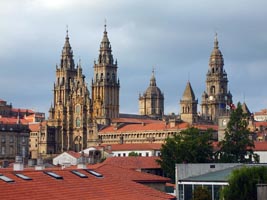 Santiago de Compostela is the final destination of the legendary medieval way of pilgrimship Camino de Santiago (Way of Saint James), now considered by Unesco a World Heritage Site. Until today it attracts visitors from all over the world thanks to its fantastic monuments. The town is named after the Apostle Saint James ("Santiago"), who is buried here.
Santiago de Compostela is the final destination of the legendary medieval way of pilgrimship Camino de Santiago (Way of Saint James), now considered by Unesco a World Heritage Site. Until today it attracts visitors from all over the world thanks to its fantastic monuments. The town is named after the Apostle Saint James ("Santiago"), who is buried here.Santiago is certainly one of Spain's most monumental towns, with a particular architectonical style all of its own. But it is as well a town plenty of life, with one of the most famous Universities and a large number of students who guarantee youthful ambience inbetween the historical walls. Also the region's cuisine is of great reputation, and it is said that nowhere you can eat better sea-food than in Galicia.
So this is a place with a really varied offer, and one of the great cultural centers of the continent.
More about Santiago ...
SightseeingThe best itineraries to discover monuments, museums, and everything else that makes Santiago worth a visit ... |
 |
 |
History and Legends... of this great town and the "Apostle of Spain". |
GastronomyThe very best of Santiago's traditional cuisine ... |
 |
 |
NightlifeWhere to have fun, Santiago's most animated regions ... |
Fiestas and FolklorePopular customs and the most interesting festivities during all the year. |
 |
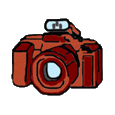 |
Photo TourA great way to get a first impression! Choose from a collection of thumbnail-photos on which items to get informed or which images to see in full-scale. |
_______________________________________________________________________________________________________________
Betanzos
Betanzos is located in la Coruna province. It is situated some 20 minutes inland from la Coruna city and 40 minutes from Santiago de Compostela. It is one of several traditional  Galician towns bidding to make an impact on foreign tourism.
Galician towns bidding to make an impact on foreign tourism.
Betanzos certainly has a plenty going for it. Firstly its location makes it simple to find with the AP9 and A6 toll roads running close by. Secondly it is a town with a lot to offer, especially to the visitor interested in medieval districts, grand churches, town gates, festivals and the genuine undiluted version of Galicia.Photo, looking towards the alameda (plaza) in the old town of Betanzos
Like most Galician towns, the older parts of Betanzos are situated around an estuarial river, or in this case the convergence of two, the rio Mendo and the rio Mandeo. One of Betanzos’s festivals involves the decorating of its many local boats for a floral flotilla.
Fiestas of all kinds are a significant feature in the life of this town and a three day medieval festival  in early July is certainly one with significant tourist appeal. (We missed it by one day.)
in early July is certainly one with significant tourist appeal. (We missed it by one day.)
As you enter Betnazos you immediately notice the white galeria balconied buildings around the riverside and as you look up into the old town this combination of white glass facades and red tiled roofs cuts its way into the hill. There is no formal town plan and no regularity or symmetry in the way that the town has evolved and this is what gives Betanzos its special character and post card appearance.
Most visitors will enter Betanzos across the Ponte Nova (bridge) and the first challenge is to find some parking. Historic towns were not designed for cars, let alone parking them and you may need to be patient and drive around for several minutes. Following the route that runs parallel with one of the rivers offers one of the best parking opportunities, but patience is required.
Entering Betanzos
The best way for a tourist to enter the old district is through one of the original town gates, e.g. the Arco da Ponte Nova, and this  can be found as an archway in the town wall close to the bridge. Once through this gateway you are within the original boundaries of Betanzos and a narrow street leads both to the right and to the left. The option to the left takes you up through the old quarter on a steep route with streets leading from it to the right. This area has a number of shops and is typical of many Galician towns.
can be found as an archway in the town wall close to the bridge. Once through this gateway you are within the original boundaries of Betanzos and a narrow street leads both to the right and to the left. The option to the left takes you up through the old quarter on a steep route with streets leading from it to the right. This area has a number of shops and is typical of many Galician towns.
Left, one of the original points of entry to Betanzos.
The town occupies the spot originally known as the Castro de Untia, an ancient settlement, and has a history that has seen it gain economic success as well as benefiting from the philanthropic activities of two of its sons in the late 19th century. Betanzos really is one of Galicia’s best historic towns and although the occasional ruinous building is present, most of the old district is in a good state of repair and enjoyable and interesting to walk around.

Left, one of many narrow and steep hills leading to and from the old town.
The highest marine cliffs in the EU

![[salida.jpg]](https://2.bp.blogspot.com/_GAlUS9ThZFQ/SGdSsyPthfI/AAAAAAAAA3Y/HhJCukKRjRw/s1600/salida.jpg)
Cariño marine cliffs are unique not only for dividing a sea and an ocean, but they are also the highest and most abrupt marine cliffs in the European Union.
When visitors arrive at Ortegal Cape Headlight they have an impressive view: apart from the marine cliffs towards the north, towards the west we can watch the overwhelming Punta do Limo, with its rocky wall, over which some rivers pour in its waters directly to the sea, forming incredible cascades several hundred meters high.
Heading southwest we find Vixía Herbeira, which is, with its 613 meters high, the highest coastal cliff in the EU. From Cariño, we can get to Herbeira viewpoint after nine kilometers along the road that takes us to San Andrés de Teixido. Herbeira and Limo cliffs can also be visited from the sea, in the Aula do Mar boat, which will provide us with an unique and genuine perspective.
The Ortegal Cape coast has just been catalogues by the EU as a Place of Community Interest, not only due to its morfologic singularity, but also to its geological and natural interest.
It is interesting to remember that there are only three spots in the planet with more antique rocks than these.
SADA
Indisputably maritime tradition, dynamic and welcoming, is today the most attractive in the nautical tourism. The wide range hotel offers visitors comfort and rest after an intense day. Sada A resource is to make it a unique tourist attraction. Needs time to walk and enjoy it.
 Paseo Marítimo
Paseo Marítimo
It stretches along the sandy city offering a panoramic view of the tranquil river. In the days low can contemplate the stamp collecting shellfish products typical of our waters. The Promenade offers spacious green areas and playgrounds and parking.
Located on the seafront are one of the most emblematic examples of modernist architecture "La Terraza", lightweight construction in wood, wrought iron and glass, originally built in the gardens of Méndez Nuñez of Corunna, and carried on until his twenties current location.
 Paseo de la Playa
Paseo de la Playa
Here you can enjoy numerous restaurants and terraces great atmosphere especially during the summer dates. The vacationers also have the picnic area known as "O Curruncho" for recreation and relaxation. It is here that takes place every year in August the sardines with the popular leading patron of the festival Sada.
 Paseo Port
Paseo Port
Here you can enjoy numerous restaurants and terraces great atmosphere especially during the summer dates. The vacationers also have the picnic area known as "O Curruncho" for recreation and relaxation. It is here that takes place every year in August the sardines with the popular leading patron of the festival Sada.
Parks and Gardens
Merendero "O Curruncho"
The area known as "O Curruncho", is situated on the Paseo de la Playa de Sada, it is a banana-conditioned with tables and benches for rest and recreation such as sports, meals and snacks, barbecues, pilgrimages. ..
 Jardines del Paseo Marítimo
Jardines del Paseo Marítimo
It stretches along the city beaches. It is a garden whose main function is to beautify the area of the Paseo Marítimo. It also can be used for sports like football and shovels and to sunbathe. Also has Playground.
The Brañas
This beautiful lake, very close to the village, occupying a large area of 23.655 hectares of high ecological and landscape, hence his deserved Environmental Plan within the protection zones.
Gaps and Junqueras this wetland were formed following the removal of clay by opencast numerous brick and tile factories (weave) located in the area. At some points the depth of the lakes reaches 5 meters.
Today, these missing Tejera (early twentieth century, until the'60s) are some remnants of the ovens that baked the tiles and bricks.
The natural habitat is conducive to the development of ducks, coots, herons, kingfisher and other birds typical of the area, as well as otters and some mustelids, and also abound mújeles large eels and convicts.
 Concern for the environment and the possibility of offering residents and visitors a natural environment transformed and recovered in Nature, was that in 1991 the City Council to commission the project "Special Plan As Brañas" avoiding action that could deprive the people of the enjoyment of this unique physical environment in which we find botanical and faunal communities that need protection. It also seeks to provide a space for activities related to environmental education.
Concern for the environment and the possibility of offering residents and visitors a natural environment transformed and recovered in Nature, was that in 1991 the City Council to commission the project "Special Plan As Brañas" avoiding action that could deprive the people of the enjoyment of this unique physical environment in which we find botanical and faunal communities that need protection. It also seeks to provide a space for activities related to environmental education.
The ease of access fosters the creation of teaching materials based on elements close to the natural environment, forming an area suitable for conservation initiatives with nature programs for youth education.
Beaches
Sada's coastline as a whole is low and sandy and steep north face, in the parishes of Carnoedo and Veiga. All along the coastline are placing outgoing and beaches.
 Playa cirrus
Playa cirrus
In the north coast, in the parish of Veiga is Cirrus Beach, with more than 200 meters long and 2000 recreation area, also has a 3rd category Camping (Ve-lo Mar) and has a complex residential adequate tourism services.
Data Cirrus Beach
- Length: 220 m.
- Width: 15 m.
- Level of occupancy: high
- Level of urbanization: Semi
- Composition: Sand
- Marina next: Sada
-
Nearest hospital: 20 km C H. Juan Canalejo OF SEA-OZA
Estrada Das Xubia, 84 - Corunna - Phone 981 17 80 00 - Sand color: White
- Grain of sand: Fine
- Terms bathing beach sheltered. Wind, calm waters
 Playa de San Pedro
Playa de San Pedro
Playa de San Pedro, about 300 meters in length located in the parish of Veiga. In the stream draining the beach that bears his name. It also has the Camping San Pedro.
Data from the Playa de San Pedro
- Length: 280 m.
- Width: 20 m.
- Level of occupancy: high
- Level of urbanization: Semi
- Composition: Sand
- Marina next: Sada
-
Nearest hospital: 20 km C H. Juan Canalejo OF SEA-OZA
Estrada Das Xubia, 84 - Corunna - Phone 981 17 80 00 - Sand color: White
- Grain of Sand: Medium
- Terms bathing beach sheltered. Wind, calm waters
 Beaches and Arnel Lourido
Beaches and Arnel Lourido
The Beaches of Arnel and Lourido in the parish of Carnoedo, both with fine sand and excellent water quality, is practically untouched. The latter gives way to a small creek bearing the same name.
Data from the Playa de Arnelas
- Length: 150 m.
- Width: 10 m.
- Occupancy levels: Low
- Urbanization level: Not urbanized
- Composition: Sand
- Marina next: Sada
-
Nearest hospital: 20 km C H. Juan Canalejo OF SEA-OZA
Estrada Das Xubia, 84 - Corunna - Phone 981 17 80 00 - Sand color: White
- Grain of sand: Fine
- Bathing conditions: Wind, calm waters
- Comment: Access on foot
![]() Beach Morazón
Beach Morazón
Morazón beach, situated in the parish of Sada, near the fishing port of Fontán. As we approach this beach we find the ruins of the fortresses that defended this coastal town: font.
Data Morazón Beach
- Length: 130 m.
- Width: 10 m.
- Occupancy levels: Low
- Level of urbanization: Semi
- Composition: Sand
- Marina next: Sada
-
Nearest hospital: 20 km C H. Juan Canalejo OF SEA-OZA
Estrada Das Xubia, 84 - Corunna - Phone 981 17 80 00 - Sand color: White
- Grain of sand: Fine
- Bathing conditions: Wind, calm waters
- Comment: Access on foot
 Playa de las Delicias
Playa de las Delicias
Playa de las Delicias, in the parish of Sada, 400 meters long and 53 wide, is situated in the town. It has all the facilities: showers, health services, emergency services, etc..
Data from the Playa de las Delicias
- Length: 400 m.
- Width: 53 m.
- Level of occupancy: high
- Urbanization level: Urban
- Composition: Sand
- Marina next: Sada
-
Nearest hospital: 20 km C H. Juan Canalejo OF SEA-OZA
Estrada Das Xubia, 84 - Corunna - Phone 981 17 80 00 - Sand color: White
- Grain of Sand: Medium
- Terms bathing beach sheltered. Wind, calm waters
A Coruña
 To the right, the 2nd century Tower of Hercules lighthouse, the oldest and most famous image of la Coruna city.
To the right, the 2nd century Tower of Hercules lighthouse, the oldest and most famous image of la Coruna city.
Confusingly, "Corunna" in English is spelt "la Coruna" in Spanish and "A Coruna" in the region of Galicia (gallego), but all refer to the same district and conurbation in northern Spain. Just to keep you on your toes, we also interchange and jump between these alternate spellings.
The greater province of A Coruna is Galicia's most significant district and has the highest population, the greatest number of towns and cities and the most prosperous economy of the region. Its three main cities are Santiago de Compostela, the Galician capital (which has its own section in galiciaguide), la Coruna, the provincial capital, and the seaport city of Ferrol. The area is also famous for its many fishing villages, amongst the most notable of which are Ribeira and Finisterre, the latter of which lies on the infamous "coast of death" (costa da morte). If you visit our Galician towns section you can find out about these and many other villages and towns of the province.
A Coruna old town, the medieval district and more
In keeping with most Galician cities, A Coruna has a medieval or monumental district and this part of the town, referred to as simply "the city", still has some remnants of 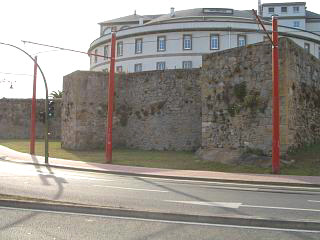 the old Roman wall that once enclosed and protected it.
the old Roman wall that once enclosed and protected it.
Right a section of A Coruna's old Roman wall at the boundary of the medieval quarter.
The old part of A Coruna town does not match up to neighbour, Santiago de Compostela, when it come to the size and age of its buildings, but it does have some areas that are well worth a visit.
We approached the old town from the bay area close to the "Castillo (castle) de San Anton" and passed by some large sections of the cities old wall, most of which has long 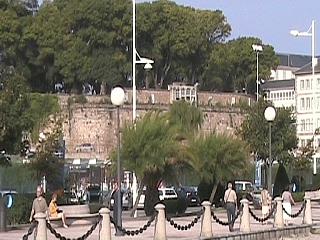 since disappeared. As you head for the old part of A Coruna from the Ocean side, you travel upwards and we passed by the "Museo Militar Regional" (military museum) which had some light artillery on display on its forecourt. To the side of this is the "Jardin de San Carlos", the walls of which can clearly be seen from the bay side below and which were once part of the fort of San Carlos (see photo above left). The fort was built in 1843 and the garden it now holds contains the tomb of Sir John Moore, famous in Galicia for his role in the battle of Elvina. This area also houses the Galician archive and has some city gates dating back to the fifteenth century close by.
since disappeared. As you head for the old part of A Coruna from the Ocean side, you travel upwards and we passed by the "Museo Militar Regional" (military museum) which had some light artillery on display on its forecourt. To the side of this is the "Jardin de San Carlos", the walls of which can clearly be seen from the bay side below and which were once part of the fort of San Carlos (see photo above left). The fort was built in 1843 and the garden it now holds contains the tomb of Sir John Moore, famous in Galicia for his role in the battle of Elvina. This area also houses the Galician archive and has some city gates dating back to the fifteenth century close by.
Churches in the medieval district
Still in the ancient part of the city, the "ciudad Vieja", there are three important churches. The first of these is one of A Coruna's oldest buildings, the Church of 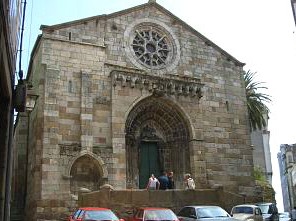 Santiago (Iglesia de Santiago). Originally built in the 12th century, it was modified in the 14th and 15th centuries and has huge historic significance on account of a 13th century statue of Saint James which it houses. Some of the more prominent aspects of the churches detailing originate from the fifteenth century and are gothic in design. The photo to the right shows the church of Santiago's main entrance.
Santiago (Iglesia de Santiago). Originally built in the 12th century, it was modified in the 14th and 15th centuries and has huge historic significance on account of a 13th century statue of Saint James which it houses. Some of the more prominent aspects of the churches detailing originate from the fifteenth century and are gothic in design. The photo to the right shows the church of Santiago's main entrance.
Also important in ecclesiastical terms is the "Iglesia de Santa Maria del Campo". 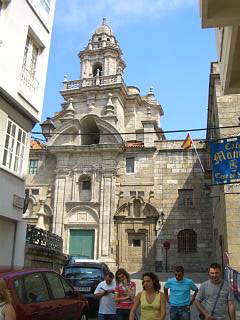 This church was constructed between the twelfth and fifteenth centuries and sits at what is probably the highest point in the city. This church has a museum archive within it (open to the public) containing pictures and documents created between the 12th and 15th centuries. It is famous throughout Spain. The church design is both Romanesque and gothic in style and, like the cathedral at Pontevedra, had much of its building costs financed by monies generated from the sea, in this case the "Guild of Seafarers".
This church was constructed between the twelfth and fifteenth centuries and sits at what is probably the highest point in the city. This church has a museum archive within it (open to the public) containing pictures and documents created between the 12th and 15th centuries. It is famous throughout Spain. The church design is both Romanesque and gothic in style and, like the cathedral at Pontevedra, had much of its building costs financed by monies generated from the sea, in this case the "Guild of Seafarers".
The third religious building in this vicinity is the church (photo to the left) and convent of Santo Domingo. Santo Domingo contains a chapel dedicated to A Coruna's patron, "La Virgen del Rosario". This convent is not as old as some of A Coruna's other buildings, but it is still worth a visit and is only a short distance away from the two churches described above.
More sights in A Coruna's old town
Located in "Tabernas Street" is the once home, now museum, of Emilia Pardo Bazan a famous Galician writer. This mansion dates back to the eighteenth century and is currently occupied by the Galician Academy.
Still staying in the general medieval part of la Corunna, other tourist stops of interest include a house where Rosalia de Castro (a Galician Poet) lived in 1873. By chance, another famous Galician writer also occupied the house next door.
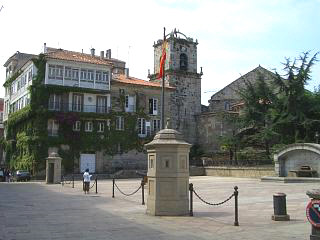
Just beyond these houses lies an important plaza called the Constitutional Square. This square has a large tiled area containing a cruceiro, fountain and a brace of cannons. It is faced by a large military building (of which there are many in A Coruna) and to the back of this square is where the church of Santiago can be found.
Above is the square, previously described, with the pitched roof of Santiago church in view, whilst below is yet another house in which the famed Galician poet, Rosalia de Castro, once lived.
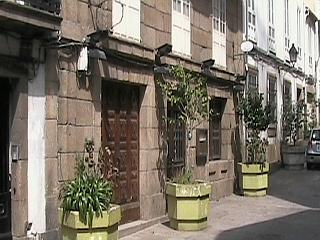
The Constitutional square (above) and Castro's house (right) are both on the same street in what is a small and compact monumental district.
For the tourist, A Coruna boasts mile upon mile of picturesque beaches, quaint fishing villages, and breath taking inland scenery with meadows, mountains and forests. It is certainly the province that has the most to offer the holiday maker and importantly has its own international airport (at Santiago de Compostela) and a large number of hotels, plus rental villas and apartments.  Most foreign visitors to Galicia will spend their entire vacation in the A Coruna province and will feel, quite rightly, that they have sampled most of what Galicia has to offer without venturing beyond this provincial boundary. Certainly it is possible to see examples of the regions most impressive buildings, monuments, beaches, festivals and landscapes in A Corunna, but we would still recommend that the real tourist explore at least one of the other provinces as well.
Most foreign visitors to Galicia will spend their entire vacation in the A Coruna province and will feel, quite rightly, that they have sampled most of what Galicia has to offer without venturing beyond this provincial boundary. Certainly it is possible to see examples of the regions most impressive buildings, monuments, beaches, festivals and landscapes in A Corunna, but we would still recommend that the real tourist explore at least one of the other provinces as well.
Exploring this province is relatively easy and is made all the more enjoyable by the fact that you do not have to travel mile upon mile between its various towns and cities. A drive down its coast will service you with a different town every ten minutes, whist motorways and recent highways connect to Santiago, Coruna and Ferrol with good and obvious sign posting – a novelty in Galicia. Variety is also served up in good measure in the A Corruna province and you will find medieval districts in many towns, but complemented with modern shopping areas, large supermarkets and a thriving culinary culture.
As the district most visited by international tourists, A Coruna also has a large number of Tourist Information offices and these range from the truly appalling Turgalicia head office just outside Santiago, to the many excellent information points like the one at Porto do Son and those found in the larger cities. All told if you want to sample what many tour operators now call "real" or "green" Spain, the Galician province of A Coruna is probably the best place to start.
A Coruna’s architecture – galerias and the glass city
Galicia has a wealth of buildings featuring most of the architectural styles found in Europe ranging from neo-classical and baroque to Romanesque and renaissance. But the region also has a particular approach to constructing balconies known locally as "galerias" and A  Coruna city must be the district’s capitol when it comes to these design features.
Coruna city must be the district’s capitol when it comes to these design features.
A galeria is nothing more than a balcony, but one that is enclosed in a glass frame protecting it from Galicia’s cool winters and making it usable all year round. Galerias can appear at first floor level, or on the six floor of a six storey building and there are many variances on the basic design. Those in shot to the right are on Marina Avenue which overlooks the bay of Coruna.
The reason galerias are so prevalent and significant in A Coruna is two fold. Firstly, unlike Galicia’s other provincial capitols, a large part of the city is "modernist" and was built in the late nineteenth and early twentieth centuries – the galeria design was especially popular during this period. Secondly, the original fisherman’s houses (that lined the harbour and port) were built with galerias and subsequent structures that replaced, or were added to them continued this style.
Galerias Corunesas
If you want to see galerias at their best, then A Coruna city is definitely the place to visit and you have two great panoramic processions of galeria style buildings to look at.  The first is the harbour front area of "Marina Avenue", often called the "glass city" or "crystal city". This is the spot where the original fishermen’s houses were, but today most of this area contains multi-storey offices and apartment blocks all of which are "loaded" with galerias. On a clear day, when the sun faces the harbour front during the evening, the reflection can be blinding and provides an impressive spectacle for all of the city’s visitors. This area around the Marina is called the "Galerias Corunesas"
The first is the harbour front area of "Marina Avenue", often called the "glass city" or "crystal city". This is the spot where the original fishermen’s houses were, but today most of this area contains multi-storey offices and apartment blocks all of which are "loaded" with galerias. On a clear day, when the sun faces the harbour front during the evening, the reflection can be blinding and provides an impressive spectacle for all of the city’s visitors. This area around the Marina is called the "Galerias Corunesas"
Away from the Marina
Although A Coruna’s harbour is famous for its "glass face", a short walk into the city serves up streets with just as many examples, and even more varied styles, of galeria on display. The main areas in which you can see them are the streets of Juana de Vega, Picavia, Feijoo, Plaza de Lugo and Plaza de Pontevedra.  One particular street (the name of which I neglected to write down) has standard shop and business premises at ground level, but every possible style of galeria above. The whole area has a feel and atmosphere that is totally different to anywhere else we have visited in Galicia and sets A Coruna apart from other cities like Lugo and Pontevedra.
One particular street (the name of which I neglected to write down) has standard shop and business premises at ground level, but every possible style of galeria above. The whole area has a feel and atmosphere that is totally different to anywhere else we have visited in Galicia and sets A Coruna apart from other cities like Lugo and Pontevedra.
At a first glance many of the galerias appear very similar to one another, but on a closer  inspection many subtle differences become evident. These range from the size, style and colour of the glass frames, to the way that the galerias interact with their enclosing building’s facade and more standard open balconies. Many buildings alternate two or three levels of galeria with an open balcony, or reserve the galerias for only the top most floors of the building. Some galerias also have intricate detailing at sill level, whilst others are supported on ornate sculptured masonry – there is no fixed style.
inspection many subtle differences become evident. These range from the size, style and colour of the glass frames, to the way that the galerias interact with their enclosing building’s facade and more standard open balconies. Many buildings alternate two or three levels of galeria with an open balcony, or reserve the galerias for only the top most floors of the building. Some galerias also have intricate detailing at sill level, whilst others are supported on ornate sculptured masonry – there is no fixed style.
Elsewhere in the town, galerias are also evident, but their monopoly is lost and they blend in with all the other buildings and architectural styles that la Corunna has to offer. Averting the eyes upwards remains the best way to appreciate them and if you want
The Maria Pita square
The Maria Pita square is probably A Coruna’s main city plaza and takes its name from the town’s heroine, Maria Pita. below is a shot of some of the terraced buildings that suround the plaza, with galerias at the top level.

Maria Pita herself came to notoriety as a result of her role in Sir Francis Drake’s attack on A Coruna in 1589 and she is credited with playing a critical part in reducing the losses of the Corunans during this assault. A new cultural museum in A Coruna has sections celebrating Pita’s life and also acts to illuminate the period during which she lived. I believe that her house may also be part of the exhibit, but am happy to be corrected on that fact!
The square or plaza to which Pita gives her name is grand to say the least. The main entrance (which you approach from the city’s harbour side) is distinguished and gives the impression that you are walking into a Royal court.  This impression is further enhanced by the Town Hall and Council building (Palacio Municipal) which is truly monumental in both its scale and incredibly ornate detailing. The photo of this building (left) really does not do it justice and the three domed towers at its front are topped with what appears to be bronze as it glistens in the sun. This building also has a long colonnaded archway traversing its main facade and completely dominates the large square. Its appearance does however suggest a greater age than the structure really lays claim to – it was actually built in the early 20th century and is less than 100 years old. In addition to various chambers and meeting rooms, the Palacio Municipal contains a clock museum.
This impression is further enhanced by the Town Hall and Council building (Palacio Municipal) which is truly monumental in both its scale and incredibly ornate detailing. The photo of this building (left) really does not do it justice and the three domed towers at its front are topped with what appears to be bronze as it glistens in the sun. This building also has a long colonnaded archway traversing its main facade and completely dominates the large square. Its appearance does however suggest a greater age than the structure really lays claim to – it was actually built in the early 20th century and is less than 100 years old. In addition to various chambers and meeting rooms, the Palacio Municipal contains a clock museum.
Below, a close of the Palacio Municipal showing some of the detailed masonry work that the building displays.  After the initial awe of the City Hall, the other buildings surrounding the Maria Pita plaza are, whilst not disappointing, slightly less grandiose. That said, many are typical examples of the best of la Coruna’s architecture and include galerias and the region’s main building component of granite. All these buildings are either interconnected, or in very close proximity to one another giving the square an enclosed, but still light and airy feel. Unlike some of Galicia’s other plazas, the Maria Pita square offers attractive facades in all four directions and had all the tourists actively making use of their cameras and videos whilst we were there.
After the initial awe of the City Hall, the other buildings surrounding the Maria Pita plaza are, whilst not disappointing, slightly less grandiose. That said, many are typical examples of the best of la Coruna’s architecture and include galerias and the region’s main building component of granite. All these buildings are either interconnected, or in very close proximity to one another giving the square an enclosed, but still light and airy feel. Unlike some of Galicia’s other plazas, the Maria Pita square offers attractive facades in all four directions and had all the tourists actively making use of their cameras and videos whilst we were there.
Also in this plaza is a statue to its "name-sake" heroine and several bars and restaurants, plus one of A Coruna’s tourist information points (at the opposite end to the Council offices). At the time of our visit, the square was also being used for festival concerts and was decked out with a large stage and lighting rig. Both Santiago de Compostela and A Coruna manage to attract major artists and musicians as performers in their main fiesta events.
Iglesia de San Jorge
Although not in the Maria Pita square itself, the square does offer a view of the small but  elegant church of St. George (Iglesia de San Jorge), which you reach by exiting the plaza to the left of the Palacio Municipal. This church was built in the eighteenth century and is in the typical baroque style of that period. It has a slender and almost elongated appearance with two bell towers and also has the addition of an elaborate cruceiro in the small courtyard in front of it. It was designed by Architect Domingo de Andrade.
elegant church of St. George (Iglesia de San Jorge), which you reach by exiting the plaza to the left of the Palacio Municipal. This church was built in the eighteenth century and is in the typical baroque style of that period. It has a slender and almost elongated appearance with two bell towers and also has the addition of an elaborate cruceiro in the small courtyard in front of it. It was designed by Architect Domingo de Andrade.
Right, a photo of the church of Saint George just outside the Pita square.
The Promenade and Marina front at A Coruna
One of A Coruna’s most visible features is its relatively new sea facing promenade and the interesting buildings and sights that line it.  The main city is set back slightly from this walkway and there is also a road that separates the path from the town.
The main city is set back slightly from this walkway and there is also a road that separates the path from the town.
The promenade was started in the late nineteen eighties and the ultimate goal is that it will extend around the greater city to a total length of approximately eight miles. At exactly what stage the project is at the present we could not determine, but it gives the impression of being complete and certainly runs around the city bay and beyond. Above, part of the wide sea facing promenade.
The reason for mentioning the prom’ so prominently is two fold. Firstly, if you leave the city center and explore the bay and harbour area you will no doubt walk along the promenade which is well designed and attractive. Secondly, this path also has several of A Coruna’s tourist high points on its trail and allows you to leave and re-enter the various district of the town.
If you are not of an energetic disposition, walking the promenade is not your only option. A tram system runs along part of its length and has important tourist stops at some of the city’s main sights - although the ride itself is now one of A Coruna’s tourist activities.
What to see on the promenade
Aside from the combination of ocean and city views, the prom’ has some of the city’s most important visitor attractions and one of them is the Castillo de San Anton, now a museum.  This castle (photo below) sits on a small headland that divides the main port area of A Coruna from the larger bay of A Coruna. The castle was originally built in the sixteenth century, but altered and amended over time. It strikes an imposing image, particularly at night when is has some subtle illumination. Visiting the museum requires the purchase of a ticket and the artefacts inside it are varied, but all connected to the surrounding area.
This castle (photo below) sits on a small headland that divides the main port area of A Coruna from the larger bay of A Coruna. The castle was originally built in the sixteenth century, but altered and amended over time. It strikes an imposing image, particularly at night when is has some subtle illumination. Visiting the museum requires the purchase of a ticket and the artefacts inside it are varied, but all connected to the surrounding area.
Also reached alternatively by the promenade, tram or car, is la Corunna’s most famous symbol, its lighthouse called the Tower of Hercules. You can find out more about it by clicking this link.
If you follow the route of the promenade round to the small bay known as the "Ensenada  del Orzan", you will encounter one of the city’s newer, but equally striking buildings. This building is the "Domus", an interactive museum dedicated to man and everything connected to him. It was designed by Arata Isozaki and looks completely different to everything else in A Coruna. Right, the Domus.
del Orzan", you will encounter one of the city’s newer, but equally striking buildings. This building is the "Domus", an interactive museum dedicated to man and everything connected to him. It was designed by Arata Isozaki and looks completely different to everything else in A Coruna. Right, the Domus.
Continuing the promenade route beyond the Domus, you reach the city beaches of "Riazor" and "Orzan", both of which have large waves and are ideal for surfing and you can also enter some of the newer district of the town at this point.
At the opposite and perhaps main section of the promenade, you have A Coruna’s large and impressive port. The city still undertakes fishing and naval activities, but three quarters of  its traffic is now industrial including oil and coal cargos. Large Cruise liners also dock at la Corunna and the bay is constantly busy with ships embarking and disembarking.
its traffic is now industrial including oil and coal cargos. Large Cruise liners also dock at la Corunna and the bay is constantly busy with ships embarking and disembarking.
Other sights that you can enjoy, or access, from the prom’ include the "Millenium Obelisk", a giant needle like structure (as pointless as every other millennium project I have seen), the futuristic and attention grabbing port control building (photo to the left), some sections of the old town’s original Roman wall and the city’s modern Aquarium.
A Coruna’s trams
Many of Europe’s major cities now have some form of tram system to help move people around and most are ugly and inefficient. The one at A Coruna is however somewhat different as the photographs will testify.
A Coruna’s trams come in different colours which I believe are red, white, yellow, blue and 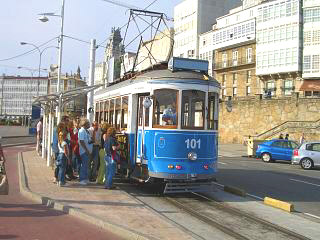 green. At a first glance the trams appear to date back to the turn of the twentieth century and look very reminiscent of those found in Britain at that time. On getting on to one of these trams, the clean and fresh interior appears to set the record straight and suggest that they are in fact modern replicas of older models – at least that is what I thought. Above right, the blue tram that we rode on.
green. At a first glance the trams appear to date back to the turn of the twentieth century and look very reminiscent of those found in Britain at that time. On getting on to one of these trams, the clean and fresh interior appears to set the record straight and suggest that they are in fact modern replicas of older models – at least that is what I thought. Above right, the blue tram that we rode on.
The tram system runs from the "sea front" center of the "Puerto de a Coruna" encircling the headland and round to the middle of the "Ensenada del Orzan". On route it makes several stops including those at the "Tower of Hercules" lighthouse, the "Domus" museum and the "castle of St. Anton". The cost of travelling the full (one way) journey was one euro per person – you pay twice if you want to go there and back.
When we took the tram is was a hot August day and the breeze that came through the open 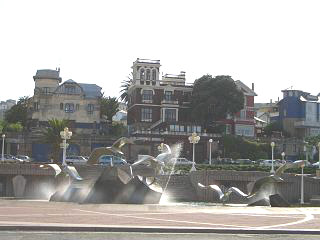 windows was reward enough. That said, the route is highly scenic and, aside from giving you easy access from one bay to the next, also offers some great views of the coastline, the town and some of its monuments and beaches.
windows was reward enough. That said, the route is highly scenic and, aside from giving you easy access from one bay to the next, also offers some great views of the coastline, the town and some of its monuments and beaches.
Among the many sights passed by on the tram was an ornimental landscaped fountain which you can see in the photo to the left, but the entire journey offered great views out to sea.
Finally, back to the trams themselves. They get their power from overhead electricity cables supported on red curvy aesthetic iron poles and each tram can travel in both directions without 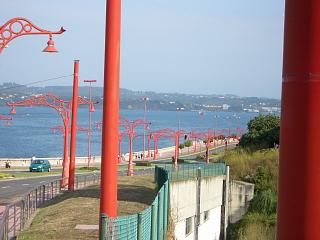 turning around. It sounds simple, but it is actually quite ingenious. At the end of each journey the driver "evicts" the passengers and then pushes each of the bench seat’s back rests against the direction of imminent travel. The double sided backrests rotate from one end of the seat to the other resulting in the "facing direction" of each seat being reversed. The driver then engages the controls at the opposite end of the tram and the job is done. The whole process takes about two minutes.
turning around. It sounds simple, but it is actually quite ingenious. At the end of each journey the driver "evicts" the passengers and then pushes each of the bench seat’s back rests against the direction of imminent travel. The double sided backrests rotate from one end of the seat to the other resulting in the "facing direction" of each seat being reversed. The driver then engages the controls at the opposite end of the tram and the job is done. The whole process takes about two minutes.
So what about the origin and history of the trams themselves!
When we were finally ready to exit we approached the driver and asked where the trams were 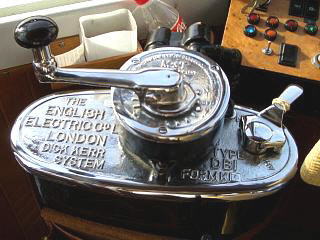 made and how old they were? The driver simply pointed towards the small highly polished dashboard console. Our tram, the blue one in the photos, was made by the "English Electric Co. Ltd, London" just after the turn of the twentieth century and was now approaching one hundred years old. I doubt that there will be a single example of one of these trams anywhere in the UK – thank God for the foresight of someone in A Coruna.
made and how old they were? The driver simply pointed towards the small highly polished dashboard console. Our tram, the blue one in the photos, was made by the "English Electric Co. Ltd, London" just after the turn of the twentieth century and was now approaching one hundred years old. I doubt that there will be a single example of one of these trams anywhere in the UK – thank God for the foresight of someone in A Coruna.
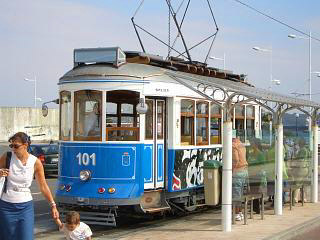
To find out about another "British – A Coruna" connection, follow this link to our page about Scottish military leader Sir John Moore. Hardly mentioned in British history, he is a hero in A Coruna and Galicia.
Right, one last shot of the tram.
Beaches in la Coruna province
The province of A Coruna is littered with some of the best beaches in the whole of Spain. A Coruna’s coastline is long and has many bays, coves and inlets dotted along its length and nearly all have a beach within them.
Trying to list all of these beaches would be a long and meaningless task, but you can find details of the main beaches associated with each of la Coruna’s towns by selecting othe
A Coruna's towns button (right menu) and looking up the location in question in the sub-menu that will then appear in the right menu bar. Some of these places, eg Noia and Rianxo, will have a separate page with local beach details.
A Coruna city’s beaches
The city of A Coruna has several beaches, the first two run below the new city promenade and are called playa del Orzan and playa de Riazor. Both are popular and busy  and can be easily accessed from the city. These beaches face outwards towards the open sea and the Orzan cove, where they lie, sits behind the headland that separates this area from the main shipping port and marina. Both these beaches have large waves and are ideal for surfers. They are also supervised with lifeguards. Above right, the far end of the beach at Orzan.
and can be easily accessed from the city. These beaches face outwards towards the open sea and the Orzan cove, where they lie, sits behind the headland that separates this area from the main shipping port and marina. Both these beaches have large waves and are ideal for surfers. They are also supervised with lifeguards. Above right, the far end of the beach at Orzan.
Also in the Orzan bay is the "playa de las Amorosas".
A little further away is the beach of San Amaro. This beach is very close to the Tower of Hercules (on the projecting headland) and resides in a tiny cove that is more protected than those above. It is also less accessible. A similar beach called "playa das Lapas" also has its own tiny inlet on the projecting headland, but is not as popular.
More beaches
For information about more beaches, see the Galician towns guide for details of la Corunna’s sandy stretches close to Noia, Muros, Ribeira, Rianxo, A Pobra do Caraminal, Porto do Son, Boiro, Santa Cruz and Ferrol.  As a taster, the photograph to the left is one of our favourites "playas". The beach is called la praia de Queiruga and is just about in the Porto do Son principality. Unlike many other hidden beaches, this one faces the open ocean, has golden sand and is nearly always virtually deserted, except that is for the schools of dolphins that populate the bay.
As a taster, the photograph to the left is one of our favourites "playas". The beach is called la praia de Queiruga and is just about in the Porto do Son principality. Unlike many other hidden beaches, this one faces the open ocean, has golden sand and is nearly always virtually deserted, except that is for the schools of dolphins that populate the bay.
Towns and villages in A Coruna Province
Aside from the provincial capitol of A Coruna and the regional capitol of Santiago de Compostela, the A Coruna province has plenty to offer. It is the most highly inhabited of the four Galician districts and also the one with the greatest number of towns – especially those with some added tourist interest.

In addition to the two cities above, there is a third city of Ferrol, just north of la Corunna city and this is the port from which the Spanish Armada sailed.
Right, the town of Muros on the A Corunan coast.
Looking at smaller urbanizations, this province is rich with coastal towns, ports and fishing villages and you can find out about many of them here in galiciaguide. Any embolden text (boxed in yellow where the curser transforms into a hand) is a clickable link that can take you to a page or section covering the place in question. Some of these towns will have several pages dedicated to them. To find out more just click the appropriate link below.
Our opinion of A Coruna City
The first thing that hits you about the city of A Coruna is its scale, at least compared to  most of Galicia’s other large conurbations – it is big. Our first port of call was the "Tower of Hercules", the famous lighthouse that sits on an elevated position and offers panoramic views of the city. These views and its location give you a first sense of A Corunna’s overall size. Left, a view looking along the winding bay side area with its 9 km long promenade and marina.
most of Galicia’s other large conurbations – it is big. Our first port of call was the "Tower of Hercules", the famous lighthouse that sits on an elevated position and offers panoramic views of the city. These views and its location give you a first sense of A Corunna’s overall size. Left, a view looking along the winding bay side area with its 9 km long promenade and marina.
The second impression is that this is a far more modern city than Santiago de Compostela or Lugo, but that is not to say that it does not have history, it is simply that many of the interesting buildings and areas extend historically up to the 19th and early 20th centuries, rather than being held in a medieval time warp.
In terms of sight seeing attractions, A Coruna definitely has them and again they run from a 2000 year old lighthouse, which is genuinely awe inspiring, to the relatively recent "glass fronted" harbour – or so it appears when the sun hits it!
The harbour, and harbour front area, with its long and impressive promenade are high points  of Coruna city and a ride on one of the trams was a personal highlight for me. We suffered from time, or a lack of it, and would ideally have liked to spend a further day in A Coruna in order to do it justice. As a result we never got round to seeing everything we would have liked to visit. To the right is a photo of the port side "castillo de San Anton" taken at dusk.
of Coruna city and a ride on one of the trams was a personal highlight for me. We suffered from time, or a lack of it, and would ideally have liked to spend a further day in A Coruna in order to do it justice. As a result we never got round to seeing everything we would have liked to visit. To the right is a photo of the port side "castillo de San Anton" taken at dusk.
The city’s medieval district was, if not a disappointment, one that had few monumental icons to promote it. That however is not to say that it is not worth a visit, or that it has little to offer, but A Coruna is no Santiago de Compostela in the medieval stakes. Getting around also requires a fair bit of walking, or the use of some transport. This is not a city with all its interesting places crammed together in one tight location.
When you are new to a city getting information quickly and conveniently starts the day off  well and finding Tourist offices was easy – there are plenty of them and the staff we met spoke good English and were helpful.
well and finding Tourist offices was easy – there are plenty of them and the staff we met spoke good English and were helpful.
Else where we did, for the first time in Galicia, encounter an if not hostile, very anti British (possibly foreigner) attitude. Ordinarily I would put this down to someone having a bad day, but it was made quite clear to us that it was our nationality that was the problem and an email experience with another native of Coruna makes me conclude that the English (and possibly Americans too) are not universally liked in this city. Generally however, we found the people of A Coruna just like those in the rest of Galicia.
Should you visit A Coruna?
The answer depends on a variety of factors. We liked this city, but we certainly felt that it did not represent the stereotype most foreigners have of Galicia. It
.jpg?ph=123e475c31)